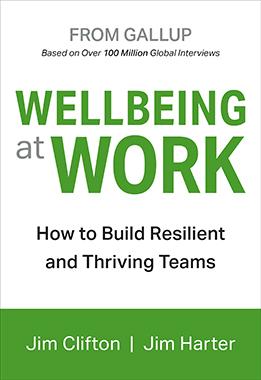Story Highlights
- Retaining top talent relies on harnessing employee burnout
- Organizational culture is pivotal to burnout recovery
- A burnout-free work environment begins with executive leaders
According to a recent Gallup analysis, 48% of America's working population is actively job searching or watching for new opportunities. The U.S. has reached a record-high quit rate and a record-high number of unfilled positions.
Perhaps it's no wonder that many employees are reconsidering their relationship to their career and work -- finding a new employer or career or leaving the workforce completely. According to Gallup's State of the Global Workplace: 2021 Report, American workers saw their stress levels soar during the events of 2020.
Many employers are throwing money at the "Great Resignation" problem -- hoping that increased wages can attract and retain enough people to keep their organization going. But this may not be an option for many organizations that are still in the wake of the pandemic's economic destruction. And a higher salary may fall short of satisfying employees who are now placing a higher value on their health and wellbeing.
The truth is: This isn't just a pay issue. It's a burnout, stress and quality of life issue. Employers must ultimately address the root causes of burnout in their organization if they want to have any chance at retaining a talented workforce in the years to come.
What decreases employee burnout while increasing productivity?
In June of 2021, 74% of employees said they experience burnout on the job at least sometimes. Burnout is so pervasive in our workplace cultures that we probably think it's inevitable. Some may even wear it as a badge of honor.
And yet Gallup has discovered that there are people whose likelihood of experiencing burnout is essentially zero. Imagine that. How many people in your workplace would say they couldn't get burned out? What would your employees do -- what would they pay -- to have a life like that?
These "nearly burnout free" employees have three things in common:
1. They are engaged at work.
How does this reduce burnout? Engaged employees are set up for success. They know what's expected of them. They have what they need to get their work done. And their manager helps them manage their workload, collaborate effectively and see a clear path to a bright future.
Here are three critical actions managers can take to reduce burnout while engaging employees:
- Focus me. Work with me to establish mutual expectations and priorities.
- Free me from unnecessary stress. Help me get the resources I need and remove barriers for me.
- Help me feel valued and supported. Ask my opinion, recognize my contribution and genuinely care about me.
2. They have high wellbeing.
How does this reduce burnout? Gone are the days of work-life balance. Now it's all about work-life integration -- bringing our best self to work (because of home) and our best self to home (because of work). Managers who have authentic relationships with their team members can help employees make their work better fit their current life situation and adjust when challenges arise.
Note: Remote workers need particular care; they have been most at risk for burnout throughout much of the pandemic. Managers can reduce remote work burnout by increasing the frequency of check-ins and being mindful of the communication and collaboration challenges inherent to remote work. They should be proactive in helping employees feel connected to their teammates and creating professional development opportunities for remote workers.
They know what's expected of them. They have what they need to get their work done. And their manager helps them manage their workload, collaborate effectively and see a clear path to a bright future.
3. They work in a culture that celebrates each person's strengths.
How does this reduce burnout? When we are using our natural talents and building on what we do best, we are more likely to enter what Mihaly Csikszentmihalyi calls a "state of flow." Time flies by, we find challenges exhilarating and we achieve exceptional performance. One person might reach this state by having meaningful conversations with people, while another might achieve it by reviewing spreadsheets. Either way, they need uninterrupted, focused time doing it -- and they need to be doing it nearly every day.
The best managers position every team member so that they can spend most of their time playing to their strengths. And when managers are thinking about each person's strengths, they can individualize feedback and goal setting in a way that feels inspiring rather than daunting.
For teams, focusing on strengths improves collaboration and lessens the strain on each member while inspiring a sense of shared purpose and camaraderie. Doing things outside of our talent comfort zone is more exhausting -- thus, more likely to lead to burnout. But when we know that someone on our team can handle (and even love) those tasks we dread, it lifts our work burden considerably. Teams that know how to play to their strengths together are more productive, are safer and have less turnover.
All three of these elements are critical responsibilities of employers.
Managers play an essential role in decreasing burnout. But a manager's effectiveness ultimately comes down to their employer. In addition, employers are responsible for creating a culture that supercharges engagement, wellbeing and strengths. They provide the mindset, programs, policies, and manager training and support to make thriving lives possible. And when employers create thriving workplaces, they not only solve their retention issues -- they also boost productivity.
When managers are thinking about each person's strengths, they can individualize feedback and goal setting in a way that feels inspiring rather than daunting.
But the first step is always the same: a serious, long-term commitment from executive leadership to a true culture transformation in how people work.
The year 2020 -- from its pandemic to its political and social turmoil -- has made one thing clear: The organizations that win the talent, customers and profits of the future will be those that care for their employees best.
Create a workplace where people love what they do.
- Download our perspective paper, Employee Burnout: Causes and Cures.
- Partner with Gallup to build a better organizational culture.
- Learn about the importance of employee wellbeing.





